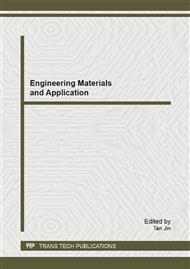[1]
Li, X., L.G. Tabil, and S. Panigrahi, Chemical treatments of natural fiber for use in natural fiber-reinforced composites: A review. Journal of Polymers and the Environment, 2007. 15(1): pp.25-33.
DOI: 10.1007/s10924-006-0042-3
Google Scholar
[2]
Bos, H.L., J. Müssig, and M.J.A. van den Oever, Mechanical properties of short-flax-fibre reinforced compounds. Composites Part A: Applied Science and Manufacturing, 2006. 37(10): pp.1591-1604.
DOI: 10.1016/j.compositesa.2005.10.011
Google Scholar
[3]
Mukhopadhyay, S. and R. Fangueiro, Physical Modification of Natural Fibers and Thermoplastic Films for Composites - A Review. Journal of Thermoplastic Composite Materials, 2009. 22(2): pp.135-162.
DOI: 10.1177/0892705708091860
Google Scholar
[4]
Li, Y. and K.L. Pickering, Hemp fibre reinforced composites using chelator and enzyme treatments. Composites Science and Technology, 2008. 68(15-16): pp.3293-3298.
DOI: 10.1016/j.compscitech.2008.08.022
Google Scholar
[5]
Shokoohi, S., A. Arefazar, and R. Khosrokhavar, Silane coupling agents in polymer-based reinforced composites: A review. Journal of Reinforced Plastics and Composites, 2008. 27(5): pp.473-485.
DOI: 10.1177/0731684407081391
Google Scholar
[6]
Keener, T.J., R.K. Stuart, and T.K. Brown, Maleated coupling agents for natural fibre composites. Composites Part a-Applied Science and Manufacturing, 2004. 35(3): pp.357-362.
DOI: 10.1016/j.compositesa.2003.09.014
Google Scholar
[7]
Lu, N., R.H. Swan, and I. Ferguson, Composition, structure, and mechanical properties of hemp fiber reinforced composite with recycled high-density polyethylene matrix. Journal of Composite Materials, 2012. 46(16): p.1915-(1924).
DOI: 10.1177/0021998311427778
Google Scholar
[8]
Na Lu, S.M.B., Ian Ferguson The Effect of Alkylation on the Thermal and Mechanical Properties of Hemp Fiber Composite with Recycled High Density Polyethylene Matrix, in American Society for Composites 26th Technical Conference/Second Joint US-Canada Conference on Composites. 2011: Montreal, Quebec, Canada.
Google Scholar
[9]
Mwaikambo, L.Y. and M.P. Ansell, Chemical modification of hemp, sisal, jute, and kapok fibers by alkalization. Journal of Applied Polymer Science, 2002. 84(12): pp.2222-2234.
DOI: 10.1002/app.10460
Google Scholar
[10]
Rajulu, A.V., et al., Effect of alkali treatment on properties of the lignocellulose fabric Hildegardia. Journal of Applied Polymer Science, 2003. 90(6): pp.1604-1608.
Google Scholar
[11]
Castro, C., et al., Determination of optimal alkaline treatment conditions for fique fiber bundles as reinforcement of composites materials. Revista Tecnica De La Facultad De Ingenieria Universidad Del Zulia, 2007. 30(2): pp.136-142.
DOI: 10.21311/001.39.10.27
Google Scholar
[12]
Lu, N. and S. Oza, Thermal stability and thermo-mechanical properties of hemp-high density polyethylene composites: Effect of two different chemical modifications. Composites Part B: Engineering, (0).
DOI: 10.1016/j.compositesb.2012.03.024
Google Scholar
[13]
Kim, H.S., et al., Thermogravimetric analysis of rice husk flour filled thermoplastic polymer composites. Journal of Thermal Analysis and Calorimetry, 2004. 76(2): pp.395-404.
DOI: 10.1023/b:jtan.0000028020.02657.9b
Google Scholar


